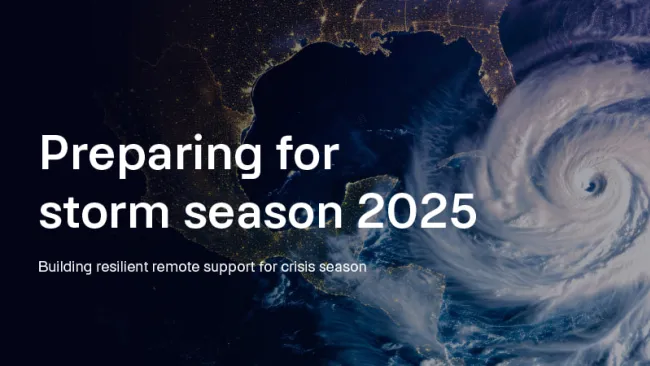When we first reported on the COVID-19 crisis it was difficult to find any sector not feeling the effects, and the public sector was one of the hardest hit. COVID-19 exposed untenable customer-related infrastructures and outdated processes throughout federal, state, and local government agencies. Many buckled under the weight of flooded contact centers, public health emergencies, and remote work mandates.
In our Summer issue we identified the need for local and federal government agencies to rethink how they deploy a remote workforce combined with digital tools such as self-service and artificial intelligence. This need has not gone away, and the time for innovation is stronger than ever.
Government organizations are now facing multiple challenges at once: Provide community-based care, deliver ongoing essential services, and implement practices to minimize the spread and exposure to COVID-19, all while under enormous budgetary pressure. According to OECD, cities, towns and villages can expect to face a $360 billion budget shortfall from 2020 through 2022. Meanwhile, citizens are demanding immediate, virtual services for their most pressing health and economic needs, as well as everyday services over the long term.
The past six months have been transformative for government and other industries. We’ve complied key customer experience (CX) trends within the public service sector, along with tips, findings, and real-world examples of how to reduce costs and improve speed and CX quality.
Accelerate CX transformation
Many organizations acted quickly when the pandemic hit to create virtual operations and mobilize staff. These temporary shifts are becoming permanent. CX modernization is no longer an IT desire, but an operational necessity of nearly every agency.
There is an incredible opportunity to keep citizens informed with asynchronous messaging to redirect calls to a text message format in Facebook Messenger, Apple Business Chat, WhatsApp, or direct SMS messaging. Messaging can be easily conducted by remote agents, and citizens prefer it as a convenient alternative to call queues.
It's easy to turn on, and quick to scale (weeks over months for typical deployment). We’ve seen in industries like retail that messaging is a feasible way to meet people on the native channels they already use.
It’s also incredibly valuable for employees, as well. A majority of the citizen and employee population will be working from home in 2020 and messaging is a more conducive channel for those in a louder, more informal workspace, especially as homeschooling becomes prevalent.
For any party, digital messaging is a way to keep a conversation going alongside challenging times and create meaningful relationships.
Automate intelligently
Government agencies face a dual economic challenge – helping businesses and the community facing financial hardship while they also cope loss of tax revenues and fees.
Two-thirds of city revenues nationwide are vulnerable to immediate losses due to local economic decline. Budgets will be more strained through 2021, which will force agencies to reprioritize technology investments and other spending, according to IDC.
There will be a dire need for what we call Intelligent Automation, an umbrella term for several automated capabilities that include Robotic Process/Desktop Automation and Intelligent Virtual Assistants. These automation processes in the back office, email, websites, and other parts of the CX ecosystem can substantially improve speed and quality of interactions while also lowering costs.
It will all be crucial in freeing up employees from manual data entry to instead handle situations that require the human touch, such as unemployment and testing information. If predications are correct, AI may impact 30% of the average federal worker’s time by 2028, according to Accenture. The real power in utilizing these processes is the ability to do more with less with technology that not only fills in the gaps, but also makes the same number of employees more equipped to do their jobs.
Prepare for the unexpected
Wild volume surges and the unpredictable nature of the pandemic’s spread have created a roller coaster nature for staffing contact centers. Findings from the U.S. Office of Personnel Management showed that prior to COVID-19, only 42% of the US federal workforce were deemed eligible for telework. It’s a traditional industry that needs to adapt fast, and they don’t want to be caught off guard again.
When it comes to workforce management and productivity, agencies want the flexibility to ramp up or down quickly with a nimble, distributed CX workforce, supported by cloud technology and intelligent automation.
Leaders can build a network of highly skilled virtual contact staff with the technology and tools to be ready to spring into action to support contact tracing, unemployment assistance, or other immediate citizen needs. In addition, an advanced digital network in times of crisis will make it easier to share resources among state or local agencies to help weather the storm.
Build community trust through security
Communities have been shaken, and it will take work to rebuild economies and daily life. Contact tracing and related data-driven COVID-19 prevention efforts will become effective only if large numbers of citizens adopt them, and citizens’ trust is crucial to make that happen.
But that is a large “if,” 62% of Americans say it is unacceptable for the government to use cellphones to track people’s locations to ensure they are complying with social distancing recommendations, sourced Pew Research Center. Data security and fraud prevention are emerging as critical factors to stop the spread of the virus and maintain security.
Be transparent in how your agency collects, uses, and keeps data safe and secure. And use your CX tools to be proactive with the public about potential fraudsters and scammers preying on the vulnerable public with fake requests for information.
The defining factor in the future of government work is treating remote and physical work equally while adjusting to different environments. Managers may need to utilize alternative monitoring with webcam platforms like Zoom to communicate face-to-face with employees and asses their working environment. In addition to retraining individuals on what is expected of them when working-from-home.
Prepare for constant change
The public sector cannot afford to be caught off guard again. When uncertainty strikes again, be it human or environment, places of contact need to understand how to pivot and act on their feet. When going forward, ask yourself:
- Are you starting with the most pressing needs? Identify your highest-volume topics, such as “how to I file for unemployment benefits?” Prioritize agents and other resources (like website FAQs or messaging channels) to quickly address customer concerns and resolve questions.
- Am I where I want to be digitally? Don’t think of digital transformation as a one-off transition. Think of it as a mindset for continually evolving the organization as needs change.
- Does my transformation have a purpose? Technology should not be introduced for technology’s sake; it needs to have purpose. Analyze the pain points and behavior of the public and where the experience could be improved before investing in new technologies.
Transformative government CX in action
These strategies were applied when a state contact center was faced with unprecedented demand for unemployment assistance related to the Coronavirus outbreak. Rather than overwhelm phone lines, the state looked to add messaging to interact with citizens quickly and efficiently from a remote environment.
Working with TTEC, the state agency added chatbot and messaging options for citizens seeking unemployment assistance such as payment status, appeal process, website login issues, filing new claims, and eligibility questions. Rather than wait on hold, callers were given an IVR prompt option to connect to a live at-home messaging agent. For website visitors, an automated chatbot connected users to a live at-home messaging agent to answer their questions.
This was the first time the state used messaging as a contact channel, and its fast adoption illustrated the public’s willingness and preference to use the cost-savings channel. Within weeks, messaging volume reached nearly 35% of all contact volume.
The program underestimated the impact and cost savings of messaging on the contact center. Out of the gate, messaging associates closed approximately twice as many contacts per hour as their voice counterparts. In less than 10 days, the number jumped to 3.5 times as many contacts closed per hour. These quick wins have set the foundation for a new primary communication channel for the government agency.
Innovate for the long-haul
Improving government CX has never been more urgent, and is essential for future growth the sector. In this new world of digital transformation and remote communication every industry needs to utilize the right tools and people together to meet modern expectations.















